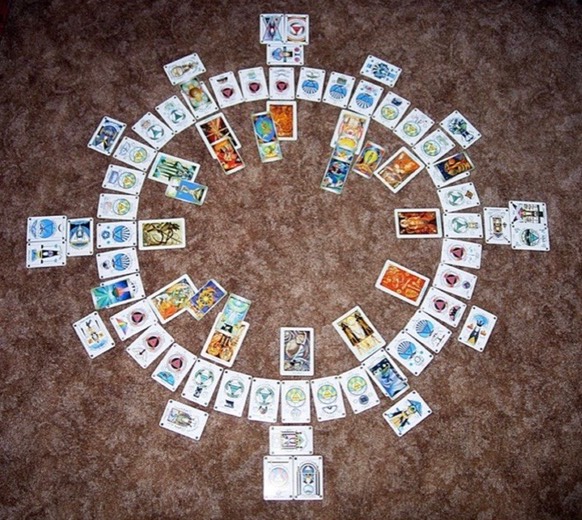By Wayne Limberger
The decks featured in this picture are the Thoth Tarot by Aleister Crowley, the Magical Tarot by Anthony Clark, Liber T, Tarot of the Stars Eternal by Roberto Negrini.
I'm an iconoclast when it comes to cartomantic systems (except for the traditional Lenormand method because it works so well, at least as far as I choose to take it). I tend to cherry-pick what works for me and ignore what doesn't. The RWS tarot deck is a good example. When reading with it, I disregard most of the narrative vignettes built into the scenic pip cards and the folklore style of interpretation that has grown up around them, and just use my Thoth-based knowledge and experience (although a flash of inspiration will occasionally arise from one of them). Another example is esoteric correspondences. If I don't need them to make narrative sense out of a card, I don't bother with them. It's an entirely utilitarian approach. That stuff is always there when I need it, but sometimes it just gets in the way, especially in public reading where few clients know anything about it.
However, any tarot enthusiast who pursues the Golden Dawn approach (and, by extension, Aleister Crowley’s) must invariably come to grips with the system of esoteric correspondences common to both. In my view, the key thing is to recognize which of them have universal applicability across all decks and which are more specialized in their application. Trying to use all of them all of the time is like a juggler trying to keep too many balls in the air.
The two that provide the broadest utility are suit and number. I'm not sure suit extends to the classical elemental associations (Fire, Water, Air, and Earth) since I've seen no evidence that decks in use prior to the Etteilla/Eliphas Levi/Golden Dawn era of occult exploration incorporated that philosophical model. These factors are serviceable for interpreting all types of tarot deck, including non-scenic "pip" decks like the Tarot de Marseille. The suit meanings seem to derive largely from playing-card divination, and metaphysical number theory goes back at least to Pythagoras. Apart from the usual number markings on the cards, numerical considerations can be used to deconstruct the various structural elements of a card's imagery. (One of the best treatments of this subject is in Joseph Maxwell's challenging book, The Tarot.)
Slightly more arcane is the concept of astrological attributions. If elemental assignments are given to the cards, zodiacal and planetary assumptions follow in an entirely natural and organic way. The cross-system match isn't a seamless one; the numbers don't add up all that well. There are 22 trump cards, 16 court cards, and 40 minor cards, while astrology offers 4 seasonal quadrants, 12 zodiacal signs (broken down into 36 decans) and seven traditional planets, Sun through Saturn. The Golden Dawn did a workmanlike "cut-to-fit" job of sorting things out in this area. Although I could (and an argument can be made for doing so), I don't typically extend these correspondences to my "pip" decks.
The third main category involves associations drawn from the Hebrew kabbalah and the Tree of Life (ToL) diagram. Although it fascinated me for years, I no longer have the time, patience or inclination to absorb all the minutiae of this elaborate system, so I limit myself to what I call the ToL’s “descending energy” model of reality: the spiritual Source of All occupies the pinnacle of creation, and the material Universe devolves from that via a series of ten increasingly palpable “emanations.” The idea that the Aces are the least tangible expression of their element (thus “potential” rather than “kinetic” energy) and the Tens are the most substantial flows literally “downhill” from this concept. Again, I’m not prone to use this system with my “pip” decks.
After that, things get more rarefied. Color theory has its place in the scheme, and the Golden Dawn had complex sets of “color scales” for the different kabbalistic divisions of the ToL, but I tend to stick with the basics for practical purposes: Wands = Red = Action; Cups = Blue = Emotions; Swords = Yellow = Intellect; and Pentacles = Green (although a case can be made for Black) = Physicality. White is reserved for Spirit, the so-called “fifth element.” I use color theory with my “pip” decks, but only in the most fundamental way.
There are also mythological, historical and cultural attributes that apply to some decks but not others (especially in the area of trump and court cards). Outside of the traditional medieval archetypes that cut across many modern decks, these have little universal applicability and are best limited to use with their source decks.
When first encountering these nested layers of meaning, rather than trying to swallow them whole, it’s prudent to have an orderly “plan of attack” that ranks them according to their relative value in interpretation, always with an eye to the fact that they may not be crucial, in whole or in part, to success in every instance.
